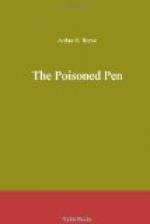This will cure your headache.
Dr. Dixon.
A servant entered with a telegram from New York. Scarcely stopping in his exposure, Kennedy tore it open, read it hastily, stuffed it into his pocket, and went on.
“Here in this fourth bottle I have an acid solution of iron chloride, diluted until the writing is invisible when dry,” he hurried on. “I will just make a few scratches on this fourth sheet of paper—so. It leaves no mark. But it has the remarkable property of becoming red in vapour of sulpho-cyanide. Here is a long-necked flask of the gas, made by sulphuric acid acting on potassium sulpho-cyanide. Keep back, Dr. Waterworth, for it would be very dangerous for you to get even a whiff of this in your condition. Ah! See—the scratches I made on the paper are red.”
Then hardly giving us more than a moment to let the fact impress itself on our minds, he seized the piece of paper and dashed it into the jar of ammonia. When he withdrew it, it was just a plain sheet of white paper again. The red marks which the gas in the flask had brought out of nothingness had been effaced by the ammonia. They had gone and left no trace.
“In this way I can alternately make the marks appear and disappear by using the sulpho-cyanide and the ammonia. Whoever wrote this note with Dr. Dixon’s name on it must have had the doctor’s reply to the Thurston letter containing the words, ’This will not cure your headache.’ He carefully traced the words, holding the genuine note up to the light with a piece of paper over it, leaving out the word ‘not’ and using only such words as he needed. This note was then destroyed.
“But he forgot that after he had brought out the red writing by the use of the sulpho-cyanide, and though he could count on Vera Lytton’s placing the note in the jar of ammonia and hence obliterating the writing, while at the same time the invisible writing in the mercurous nitrate involving Dr. Dixon’s name would be brought out by the ammonia indelibly on the other side of the note—he forgot”—Kennedy was now speaking eagerly and loudly— “that the sulpho-cyanide vapours could always be made to bring back to accuse him the words that the ammonia had blotted out.”
Before the prosecutor could interfere, Kennedy had picked up the note found in the ammonia-jar beside the dying girl and had jammed the state’s evidence into the long-necked flask of sulpho-cyanide vapour.
“Don’t fear,” he said, trying to pacify the now furious prosecutor, “it will do nothing to the Dixon writing. That is permanent now, even if it is only a tracing.”
When he withdrew the note, there was writing on both sides, the black of the original note and something in red on the other side.
We crowded around, and Craig read it with as much interest as any of us:
“Before taking the headache-powder, be sure to place the contents of this paper in a jar with a little warm water.”




